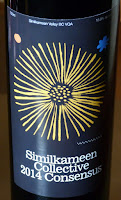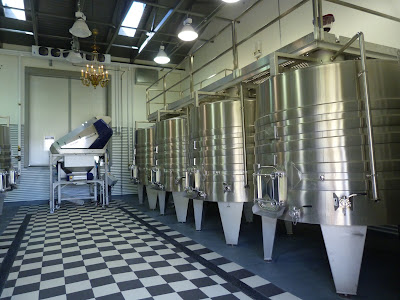Photo:FFV's Gordon Fitzpatrick
Fitzpatrick Family Vineyards
697 Highway 97S
Peachland,
BC, V0H 1X9
Among the memorable
experiences in wine touring, visiting the cellar of a sparkling wine producer
is near the top of the list.
Starting
September this year, what promises to be the Okanagan’s best sparkling wine
cellar tour will begin welcoming the public at Fitzpatrick Family Vineyards
south of Peachland. The former Greata Ranch Vineyards winery is completing a
spectacular redevelopment to accommodate a new 8,000 case winery, a little more
than half of it sparkling wine. The
underground cellars will accommodate 120,000 bottles of bubbly.
This week, months
in advance of opening its wine shop, Fitzpatrick Family Vineyards (FPV) is
releasing its first table wines. The winery’s debut sparkling wine, 380 cases
from the 2012 vintage, is completing aging and will be released this fall when
the tasting room opens.
The winery,
based on a 40-acre lakeside vineyard south of Peachland, was operated from 2003
until the spring of 2014 as Greata Ranch Vineyards by Gordon Fitzpatrick and
his father, Senator Ross Fitzpatrick, who then also owned CedarCreek Estate
Winery.
Early in
2014, CedarCreek was purchased by Anthony von Mandl, the owner of Mission Hill
Family Estate Winery. The Fitzpatricks, who had not expected von Mandl’s offer,
had been planning a $2 million renovation to CedarCreek. Instead, they turned
their attention on Greata Ranch.
“We have always bemoaned the fact that Greata did
not get the attention we thought it deserved,” says Gordon, who had also been
CedarCreek’s president. “My main focus was the brand at CedarCreek and most of
the [Greata Ranch] grapes went into CedarCreek wines. We had a wine shop and a
second label, Greata Ranch, but it never got the attention it deserved. I
wanted to see what we could do by giving Greata its own personality.”
The Fitzpatricks have a long and
emotional relationship with Greata Ranch.
“I used to come up here with my Dad,” Senator
Fitzpatrick says, recalling when his father came to buy Greata fruit for the
Oliver packing house which he managed. “This was a big beautiful peach orchard.
At one time Greata was the largest single orchard in the Okanagan Valley.
A large portion of the orchard was planted in peaches.”
The FPV Rosé is labelled The Pink Mile
in an allusion to how Greata Ranch looked in its glory days as an orchard when
the peaches were in blossom.
The property is named after George W.
Greata, a British immigrant who arrived in the Okanagan in 1895. After securing
water rights and building an irrigation line from a nearby creek, Greata
planted the first apple trees in 1901.
The orchard flourished under the
subsequent owners, the Long family. A 1949 article in the Family Herald and Weekly Star reported that the orchard's average
annual crop totalled 485 tons of cherries, pears, apricots, plums and peaches;
and the packing house also handled 25,000 cases of apples from the area each
year. The enterprise run by the Long
brothers was a major business in its time, with about 75 full-time employees
and a dock on the lake from which produce was transported to railhead.
The year after they sold it in 1965, a
very cold winter decimated the orchard. The ranch passed through several owners
and uses before becoming a derelict property with squatters’ cabins on the
shore. Senator Fitzpatrick bought it in 1994, cleaned it up and planted the
vineyard in 1995.
During the past 20 years, most of the
grapes – notably Pinot Noir and Chardonnay – ended up in CedarCreek wines. A decade
ago, as part of a real estate development project, a few vintages of Greata Reserve
Chardonnay and Reserve Pinot Noir were produced before both the luxury housing
proposal and the reserve program were shelved.
Since the sale of CedarCreek, the
Fitzpatricks have turned their full attention on recreating Greata Ranch as a
producer of premium sparkling wine.
“With our winemakers, we discussed what
they thought Greata’s best suit was,” Gordon says. “They came back with no
reservations to say sparkling. We have all of this Chardonnay and Pinot Noir.
Given the site and the acidity, that would be a natural.”
The initial vintages of sparkling wine
were made by Darryl Brooker, then the CedarCreek winemaker and how chief
winemaker at Mission Hill. He was assisted by Taylor Whelan, who made the 2014
and 2015 still wines for FFV. He had just settled in as the FFV winemaker until
this week, when he was appointed CedarCreek’s winemaker. Gordon is currently
recruiting a replacement for FFV.
Taylor (below) was born in 1985 in Campbell
River. With a biology degree from the University of Victoria, he set out to be
a marine biologist until he discovered that this career was not about “swimming
with whales, but in real life, sitting in front of a computer, running
statistics.”
Looking for a career he was more
passionate about, he studied winemaking at Brock University and got a job in
2009 at Hillebrand winery, a Niagara on the Lake winery with a major sparkling
wine program. His boss was Darryl Brooker, who moved to CedarCreek in 2010.
Taylor followed Darryl to CedarCreek in
2012 after acquiring additional winemaking experience in New Zealand and
Australia. Taylor is interested specifically in cool climate grape varieties
and in sparkling wine.
 “The winery I worked at in Tasmania was
one of the foremost sparkling producers down there, Bay of Fires,” Taylor says.
“That was one of the reasons I wanted to work at Hillebrand as well, because of
the Trius sparkling program. It is the biggest in Canada and relatively well
established. So sparkling is a large
interest of mine.”
“The winery I worked at in Tasmania was
one of the foremost sparkling producers down there, Bay of Fires,” Taylor says.
“That was one of the reasons I wanted to work at Hillebrand as well, because of
the Trius sparkling program. It is the biggest in Canada and relatively well
established. So sparkling is a large
interest of mine.”
“Production of sparkling wine in BC is
limited,” Gordon says. “Last year, total sales of BC sparkling wine were only
28,000 cases. We think there is a really good niche for it.”
Taylor had already begun to stamp a
style on FFV, making wines that are fresh and with good fruit.
“A lot of people would say that is a
character the Okanagan wines have already,” he says. “We are trying to stay
true to that. For still wines, it would be the same. The idea is to showcase
the site. It is a cool, bright, high acid site with bright fruit flavours and
tightly wound characters.”
The FFV winery is being developed to
provide a major hospitality program, in part because the business plan calls
for selling much of the production at the cellar door. Gordon’s research
included touring close to 30 sparkling wine producers in Champagne and in
California.
“We will offer in depth tours that will
focus primarily on sparkling wine,” Gordon says. “The whole winery has been
designed with that tour in mind. You will start in the gathering room; then
step out these doors and across to the vineyard; and walk along the vineyard
rows to talk about what is special about this site and why is ideal for
sparkling; and talk about viticultural practices.”
Each tour, limited to perhaps 12
persons, will last from an hour to an hour and a half. Video stations in the
cellar will show those steps in the production process not always being done
live.
“Then we come back up the stairs and
come back into this very nice gathering room, where we will do the tasting,”
Gordon says. “The tasting will be done either by Taylor or myself. It will be
hands on.”
For those not interested in a cellar
tour, there will be tasting bars and lounges with food service. Beginning in 2017,
teams of chefs will prepare lunches and, on several evenings, dinner.
“It is not just a wine brand,” Gordon
says of FFV. “I want to create a little bit of a lifestyle brand as well. That
is why there is emphasis on what we are going to be doing on site, and the
restaurant and the food, and the way we present. I want to see if we can cross
over and create what I call luxury at play.”
Here are notes on the wines.
Fitzpatrick Interloper Gewürztraminer 2015 ($18.50 for 566 cases). The models for this wine included the
great wines of Alsace. The wine is bold, with aromas and flavours of spice,
lychee, grapefruit and grapefruit rind. About 20% of the wine was fermented in
barrel and perhaps that accounts for the fleshy texture. Taylor says: “This is the one wine that I am
relatively unapologetic about being big and intense, and not afraid of residual
sugar.” 91.
Fitzpatrick The Unwinder Ehrenfelser 2015 ($18.50 for 444 cases). The winemaker’s objective with this
white variety – a star in the CedarCreek portfolio – is to make another
powerful, aromatic wine. The wine begins with an appealing fruity aroma (peach
and stone fruit), leading to flavours of apricot, peach and ripe apple. The
finish is slightly off dry. 91.
Fitzpatrick Big Leap Chardonnay 2014 ($24.50 for 345 cases). This elegant wine is fermented in
French oak barrels (seven percent new). The wine begins with aromas of citrus
and peach. On the palate, there are flavours of tangerine and apple with a very
slight hint of oak. While the wine has good weight, the bright acidity gives it
an appealing clarity and freshness. 93.
Fitzpatrick Pink Mile Rosé ($18.50 for 344 cases). This is made with Pinot Noir. Light
rose petal in hue, the wine has aromas of strawberry and flavours of strawberry
with twist of orange rind. There is a hint of residual sweetness on the finish.
90.







































